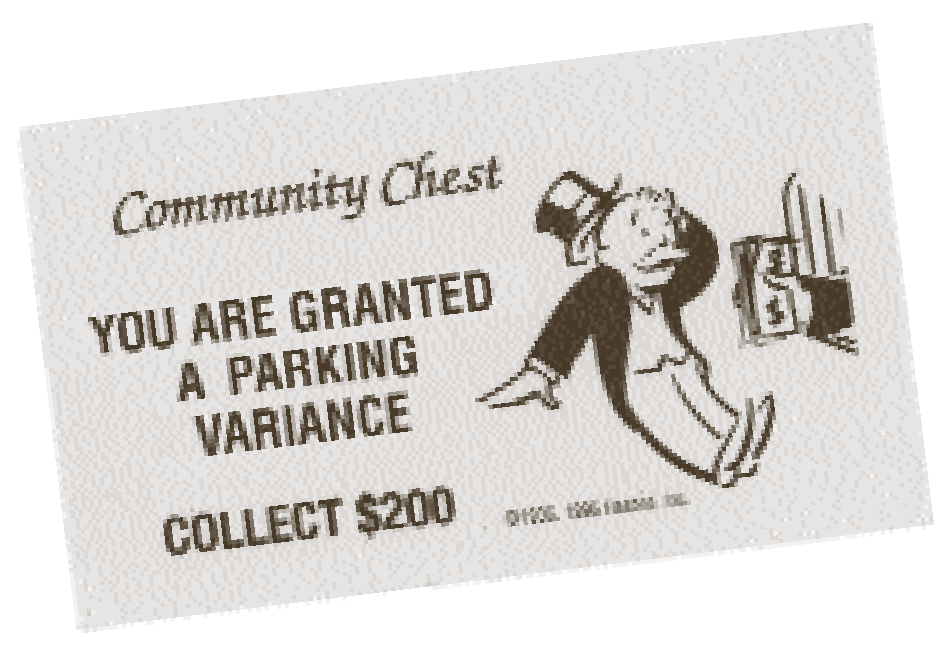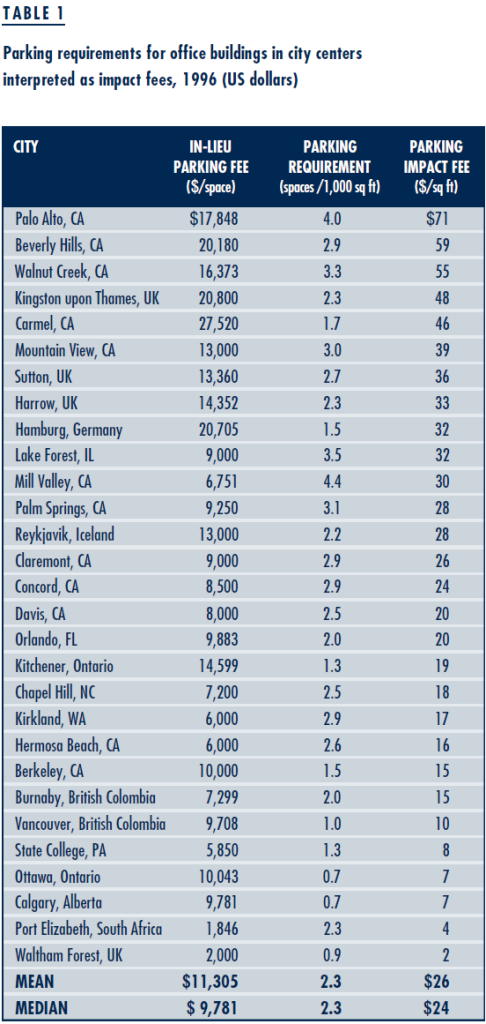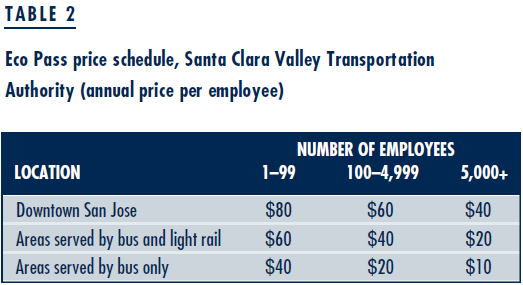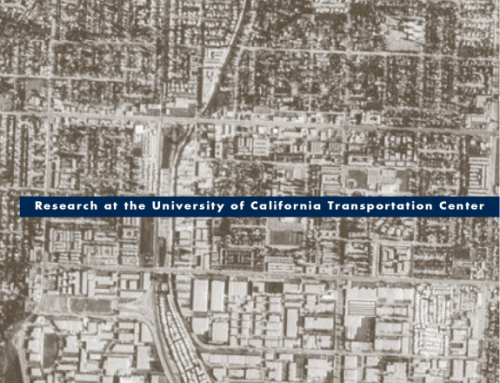We Americans first learn about free parking when we play Monopoly. Players pay rent, buy houses, build hotels, or go to jail after a toss of the dice, and one toss out of forty lands us on “Free Parking.” The odds of landing on free parking increase dramatically when we begin to drive cars because—notwithstanding the experience of commuters in some large cities—American motorists park free on 99 percent of all trips.
But there is no such thing as a free parking space. Someone must pay for it. If motorists don’t, then who does? Initially, developers pay for parking when they provide spaces to meet requirements in zoning ordinances. Because the required parking spaces raise the cost of development, the cost of parking is then translated into higher prices for everything else, and everyone pays for parking indirectly. Residents pay through higher prices for housing, consumers pay through higher prices for goods and services, employers pay through higher office rents. Only in our role as motorists do we not pay for parking.
Where the cost of parking a car is included in higher prices for other goods and services, people cannot choose to pay less for parking by using less of it. Bundling the cost of parking into higher prices for everything else therefore distorts consumer choices toward cars and away from other options.
Minimum parking requirements in zoning ordinances promote free parking, but they often hinder development on sites where it is difficult to both construct a building and provide the required parking. They can also hamper adaptive reuse of existing buildings where the new use would require expensive new parking spaces. To mitigate these problems, some cities allow developers to pay a fee in lieu of providing the required parking. For example, Palo Alto, California, allows developers to pay the city $17,848 for each parking space that’s not provided. The cities then use the fee revenue to provide publicly owned parking spaces in lieu of the privately owned parking spaces that developers would have provided.
A Survey of In-Lieu Parking Fee Programs
I surveyed the in-lieu parking programs in forty-six cities— twenty-four in the United States, seven in Canada, six in the United Kingdom, six in Germany, two in South Africa, and one in Iceland. I examined the ordinances and supporting documents for the programs and interviewed the officials who administer them.
Officials in the surveyed cities contend that in-lieu fees have advantages for both cities and developers. The following five points summarize these advantages.
- An In-lieu fees give developers an alternative to meeting parking requirements on sites where providing all the required spaces would be difficult or extremely expensive.
- Shared Public parking spaces allow shared use among different sites whose peak parking demands occur at different times. Shared public parking is more efficient than ºsingle-use private parking because fewer spaces are needed to meet the total peak parking demand. Parking that is shared among different establishments also allows motorists to park once and visit multiple sites on foot.
- Better Urban Design. Cities can put public parking lots and structures where they do not deter vehicle and pedestrian circulation. Less on-site parking allows continuous storefronts without dead gaps for adjacent surface parking lots. To improve the streetscape, some cities dedicate the first floor of public parking structures to retail use. Developers can undertake infill projects without assembling large sites to accommodate on-site parking, and architects have greater freedom to design better buildings in a more pedestrian-friendly environment.
- Fewer Variance Developers often request variances from parking requirements. These variances create unearned economic windfalls, granted to some developers but denied to others. If developers can pay cash rather than provide the required parking, cities do not need to grant parking variances and can treat all developers equitably.
- Historic The in-lieu policy makes it easier to preserve historic buildings and rehabilitate historic areas by allowing for alternative locations of parking garages.
Officials in all the surveyed cities judged the in-lieu fees as successful, and they reported that the fees had become a form of administrative relief for developers who do not want to provide the required parking spaces.
 Who Decides?
Who Decides?
Most cities allow developers the choice of paying the in-lieu fee or providing the required parking, but a few cities require developers to pay. Officials in these latter cities say mandated fees encourage shared parking, discourage proliferation of surface parking lots, emphasize continuous shopfronts, improve pedestrian circulation, reduce traffic congestion, and improve urban design.
Some cities also allow property owners to remove existing required spaces by paying in-lieu fees. This option can consolidate scattered parking spaces, facilitate reinvestment in older buildings, and encourage more efficient use of scarce land previously committed to surface parking.
Impact Fees Implicit in Parking Requirements
Many cities require developers to pay impact fees to finance public infrastructure—such as roads and schools. Parking requirements resemble  impact fees because developers must provide required infrastructure—parking spaces—to obtain building permits. The cost of required parking is typically buried in the cost of development, but in-lieu fees expose the true cost of parking spaces and allow us to express the cost of parking requirements in terms comparable to municipal impact fees. When cities require developers to pay the fees rather than provide the parking, the in-lieu fees are de facto impact fees.
impact fees because developers must provide required infrastructure—parking spaces—to obtain building permits. The cost of required parking is typically buried in the cost of development, but in-lieu fees expose the true cost of parking spaces and allow us to express the cost of parking requirements in terms comparable to municipal impact fees. When cities require developers to pay the fees rather than provide the parking, the in-lieu fees are de facto impact fees.
To compare the price of parking requirements with impact fees, we must first convert the required parking into a cost per square foot of building area. We can do this because the cities’ in-lieu fees are their estimates of the cost of providing parking spaces. The in-lieu fees therefore reveal the impact fees implicit in the parking requirements themselves.
The parking impact fee depends on (1) the parking requirement (how many spaces per 1,000 square feet), and (2) the in-lieu fee (per parking space). Table 1 presents parking requirements and in-lieu fees for office buildings in the central business districts of twenty-nine cities. The last column shows the parking impact fees implicit in the parking requirements.

The first row shows that Palo Alto requires four parking spaces per 1,000 square feet of gross floor area for office buildings. Palo Alto’s in-lieu fee is $17,848 per required parking space not provided, so the parking requirement is equivalent to an impact fee of $71 per square foot of office space (4 x $17,848 ÷ 1,000). A developer who does not provide any parking must pay the city a parking impact fee of $71 per square foot of office space.
The parking impact fees range from $71 per square foot in Palo Alto to $2 per square foot in Waltham Forest. The median parking impact fee is 2.5 times higher in the US cities than in the Canadian cities—$25 per square foot of office space in the US but only $10 per square foot in Canada. US cities have higher parking impact fees because they require more parking, not because they have higher in-lieu fees. The median parking requirement is almost three times higher in the US than in Canada—2.9 spaces per 1,000 square feet in the US but only one space per 1,000 square feet in Canada. The median in-lieu fee is lower in the US ($9,125 per space) than in Canada ($9,781 per space).
The average parking impact fee for the US cities is $31 per square foot of office space, which dwarfs the impact fees levied for all other public purposes. A 1991 survey of one hundred US cities found that the total impact fees for all purposes (roads, schools, parks, water, sewers, flood control, and the like) averaged $6.97 per square foot of office space. The average parking impact fee for office buildings is thus 4.4 times the average impact fee for all other public purposes combined. If impact fees reveal a city’s preferences for public services, then it seems that many cities’ highest priority is free parking.
Officials in most cities reported that they set the in-lieu fee below the cost of providing a public parking space because the fee would be “too high” if the city charged the full cost. When the cost of required parking is hidden in the cost of development, cost does not seem to matter. But when the cost of required parking is made explicit in cash, everyone can see that it is “too high.”
Reduce Demand Rather than Increase Supply?
Minimum parking requirements impose high costs, but reform is difficult because parking requirements are entrenched in cities’ practice and legislated in zoning ordinances. Nevertheless, allowing developers the option to finance public parking rather than provide private parking suggests another promising in-lieu option: Allow developers to reduce the demand for parking rather than increase the supply of parking.
One way to reduce the demand for parking is to make public transit a more viable alternative. For example, employer-paid transit passes reduce the demand for parking at work, and a city can therefore reduce the parking requirements for developers who make a commitment to provide transit passes for all employees at their sites. Suppose that providing free transit passes to all  employees at a site reduces parking demand there by one parking space per 1,000 square feet. In this case, a developer’s covenant to provide free transit passes to employees at the site would be an appropriate alternative to providing one required parking space per 1,000 square feet.
employees at a site reduces parking demand there by one parking space per 1,000 square feet. In this case, a developer’s covenant to provide free transit passes to employees at the site would be an appropriate alternative to providing one required parking space per 1,000 square feet.
Some transit agencies offer employers the option of buying Eco Passes that allow all their employees to ride free on all local transit lines. Eco Passes are priced according to their probability of use, and the price per employee is low because many employees do not ride transit even when it is free. Employers can therefore buy Eco Passes for all employees at a low cost. In California’s Silicon Valley, for example, the Santa Clara Valley Transportation Authority (SCVTA) charges from $10 to $80 per employee per year for Eco Passes, depending on an employer’s location and number of employees.
Because frequent riders often buy conventional transit passes, transit agencies must price these passes on the assumption that riders will use them frequently. And because transit agencies price transit passes to cover the costs imposed by frequent riders, infrequent riders will not buy them. In contrast, Eco Passes are priced like employer-paid insurance that covers every member of a defined population, and the price of an Eco Pass is therefore much lower than the price of a conventional transit pass. For example, the SCVTA’s price for its Eco Pass is only 2 to 19 percent of the price for its conventional transit pass ($420 per year).
Cost-Effectiveness of Employer-Paid Transit Passes
Minimum parking requirements increase the supply of parking, while providing Eco Passes increases the demand for transit. We can estimate the cost-effectiveness of providing Eco Passes in lieu of parking spaces by combining their cost with information on how they reduce the cost of meeting parking requirements.
Employers in Silicon Valley pay $10 to $80 per employee per year for Eco Passes. If there are four employees per 1,000 square feet of office space, Eco Passes will cost from 4¢ to 32¢ per square foot of office space per year. How does this cost of offering Eco Passes to all employees compare with the resulting reduction in the capital cost of providing parking spaces?
The SCVTA serves two of the surveyed cities that have in-lieu parking fees. The cost of providing the parking required for office buildings is $39 per square foot of office space in Mountain View and $71 per square foot of office space in Palo Alto. A survey of Silicon Valley commuters whose employers offered Eco Passes found that commuter parking demand declined by approximately 19 percent. A city might in this case grant a 19-percent reduction in the parking requirement for office developments that offer Eco Passes for all commuters. If the Eco Passes reduce parking requirements by 19 percent, they will reduce the capital cost of providing the required parking spaces by $7.41 per square foot of office space in Mountain View ($39 x 19 percent) and by $13.49 per square foot of office space in Palo Alto ($71 x 19 percent).
In this example, spending between 4¢ and 32¢ per square foot of office space per year to provide Eco Passes would reduce the capital cost of required parking by between $7.41 and $13.49 per square foot. We can convert this relationship into the potential return on each dollar spent for Eco Passes: spending $1 a year to provide Eco Passes will reduce the up-front capital cost to provide required parking by between $23 ($7.41 ÷ 0.32) and $337 ($13.49 ÷ 0.04). The annual cost of the Eco Passes ranges between 0.3 percent and 4.3 percent of the reduction in the up-front capital cost of the required parking. Eco Passes will also reduce the operating and maintenance costs for parking because fewer spaces are required. The low cost of reducing parking demand compared with the high cost of increasing the parking supply shows that Eco Passes are a cost-effective way to reduce the high cost of meeting parking requirements mandated by zoning ordinances.
Conclusion: The High Cost of Minimum Parking Requirements
The impact fees implicit in parking requirements dwarf the impact fees for all other public purposes combined. The evidence of high parking impact fees should make it hard for planners to ignore the high cost of minimum parking requirements. Given the high cost of required parking spaces, planners should not assume that the demand for parking automatically justifies minimum parking requirements.
Planners who set parking requirements rarely think about the price that motorists pay for parking. But demand depends on price, and most motorists park free. Planners who require enough spaces to satisfy the existing demand for parking make the mistake of requiring enough spaces to satisfy the demand for free parking, no matter how much it costs. In-lieu parking fees unveil the high cost of this mistake.
Further Readings
Donald Shoup, “An Opportunity to Reduce Minimum Parking Requirements,” Journal of the American Planning Association, v. 61, no. 1, pp. 14-28, Winter 1995.
Donald Shoup, “The High Cost of Free Parking,” Journal of Planning Educaction and Research, v. 17, no. 1, pp. 3-20, Fall 1997.
Donald Shoup, “In Lieu of Required Parking,” Journal of Planning Education and Research, v. 18, no. 4, pp. 307-320, Summer 1999.
Willson, Richard, “Suburban Parking Requirements: A Tacit Policy for Automobile Use and Sprawl,” Journal of the American Planning Association, v. 61, no. 1, pp. 29-42, 1995.








